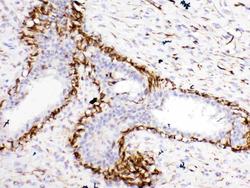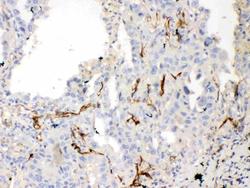A00181
antibody from Boster Biological Technology
Targeting: BCL2L1
Bcl-X, bcl-xL, bcl-xS, BCL2L, BCLX, PPP1R52
Antibody data
- Antibody Data
- Antigen structure
- References [3]
- Comments [0]
- Validations
- Immunohistochemistry [1]
Submit
Validation data
Reference
Comment
Report error
- Product number
- A00181 - Provider product page

- Provider
- Boster Biological Technology
- Product name
- Anti-Bcl-XL/BCL2L1 Antibody Picoband™
- Antibody type
- Polyclonal
- Description
- Polyclonal antibody for BCL XL/BCL2L1 detection. Host: Rabbit.Size: 100μg/vial. Tested applications: IHC-P. Reactive species: Human. BCL XL/BCL2L1 information: Molecular Weight: 26049 MW; Subcellular Localization: Isoform Bcl-X(L): Mitochondrion inner membrane . Mitochondrion outer membrane . Mitochondrion matrix . Cytoplasmic vesicle, secretory vesicle, synaptic vesicle membrane . Cytoplasm, cytosol . Cytoplasm, cytoskeleton, microtubule organizing center, centrosome. Nucleus membrane ; Single-pass membrane protein ; Cytoplasmic side . After neuronal stimulation, translocates from cytosol to synaptic vesicle and mitochondrion membrane in a calmodulin-dependent manner (By similarity). Localizes to the centrosome when phosphorylated at Ser-49; Tissue Specificity: Bcl-X(S) is expressed at high levels in cells that undergo a high rate of turnover, such as developing lymphocytes. In contrast, Bcl-X(L) is found in tissues containing long-lived postmitotic cells, such as adult brain.
- Reactivity
- Human, Mouse, Rat
- Host
- Rabbit
- Vial size
- 100μg/vial
- Concentration
- Add 0.2ml of distilled water will yield a concentration of 500ug/ml.
- Storage
- At -20°C for one year. After reconstitution, at 4°C for one month. It can also be aliquoted and stored frozen at -20°C for a longer time. Avoid repeated freezing and thawing.
- Handling
- Add 0.2ml of distilled water will yield a concentration of 500ug/ml.
Submitted references BuFeiXiaoJiYin ameliorates the NLRP3 inflammation response and gut microbiota in mice with lung cancer companied with Qi-yin deficiency.
The Inhibition of Gastric Cancer Cells' Progression by 23,24-Dihydrocucurbitacin E through Disruption of the Ras/Raf/ERK/MMP9 Signaling Pathway.
Azithromycin synergistically enhances anti-proliferative activity of vincristine in cervical and gastric cancer cells.
Jiang RY, Wang T, Lan QY, Qin YC, Man TT, Sun H, Li ZL, Zhong XT, Mo CM, Rong Z
Cancer cell international 2022 Mar 15;22(1):121
Cancer cell international 2022 Mar 15;22(1):121
The Inhibition of Gastric Cancer Cells' Progression by 23,24-Dihydrocucurbitacin E through Disruption of the Ras/Raf/ERK/MMP9 Signaling Pathway.
Liu H, Wang H, Dong A, Huo X, Wang H, Wang J, Si J
Molecules (Basel, Switzerland) 2022 Apr 22;27(9)
Molecules (Basel, Switzerland) 2022 Apr 22;27(9)
Azithromycin synergistically enhances anti-proliferative activity of vincristine in cervical and gastric cancer cells.
Zhou X, Zhang Y, Li Y, Hao X, Liu X, Wang Y
Cancers 2012 Dec 4;4(4):1318-32
Cancers 2012 Dec 4;4(4):1318-32
No comments: Submit comment
Supportive validation
- Submitted by
- Boster Biological Technology (provider)
- Main image

- Experimental details
- IHC analysis of Bcl-XL using anti-Bcl-XL antibody (A00181). Bcl-XL was detected in paraffin-embedded section of human mammary cancer tissues. Heat mediated antigen retrieval was performed in citrate buffer (pH6, epitope retrieval solution) for 20 mins. The tissue section was blocked with 10% goat serum. The tissue section was then incubated with 1μg/ml rabbit anti-Bcl-XL Antibody (A00181) overnight at 4°C. Biotinylated goat anti-rabbit IgG was used as secondary antibody and incubated for 30 minutes at 37°C. The tissue section was developed using Strepavidin-Biotin-Complex (SABC)(Catalog # SA1022) with DAB as the chromogen.
- Additional image

 Explore
Explore Validate
Validate Learn
Learn Western blot
Western blot Immunohistochemistry
Immunohistochemistry